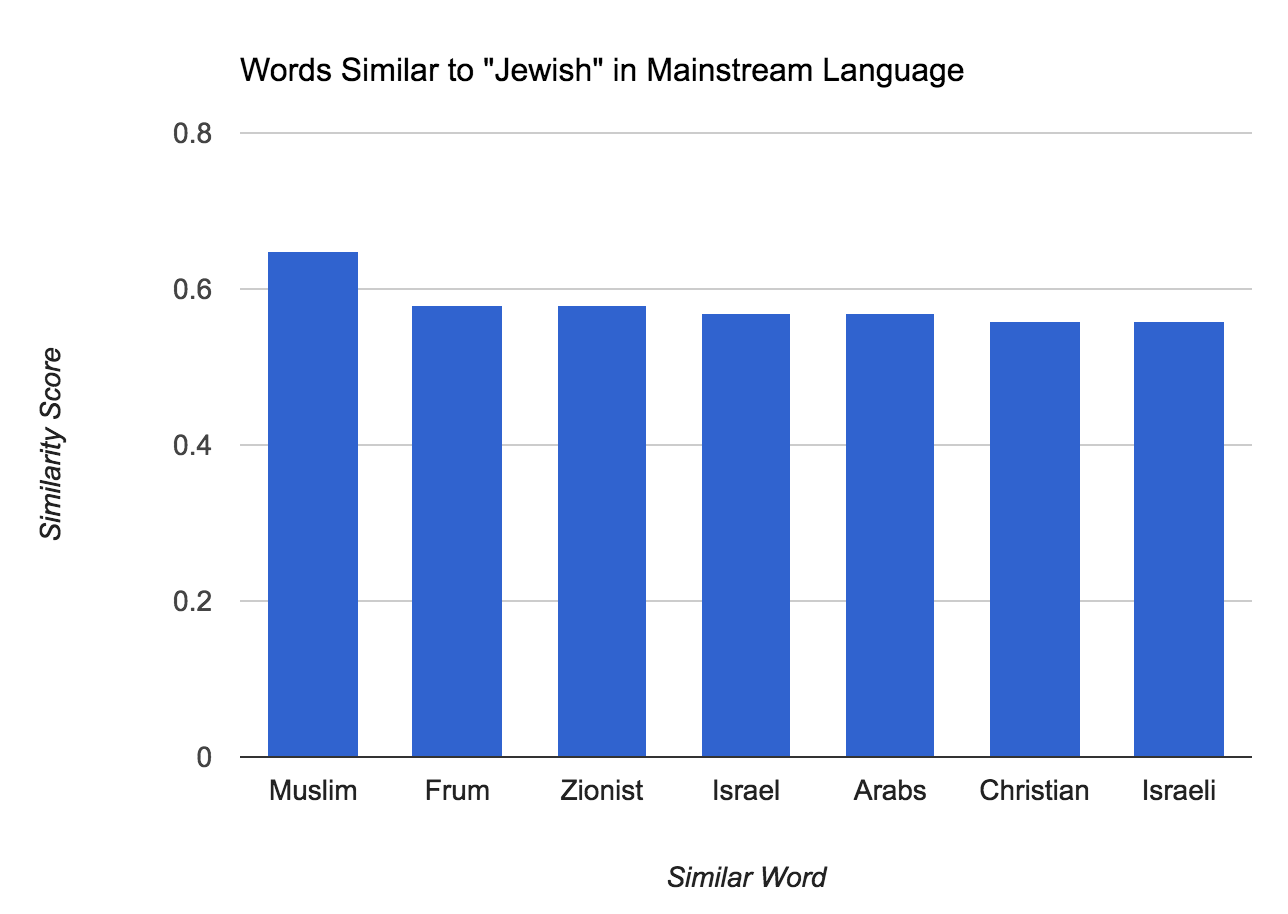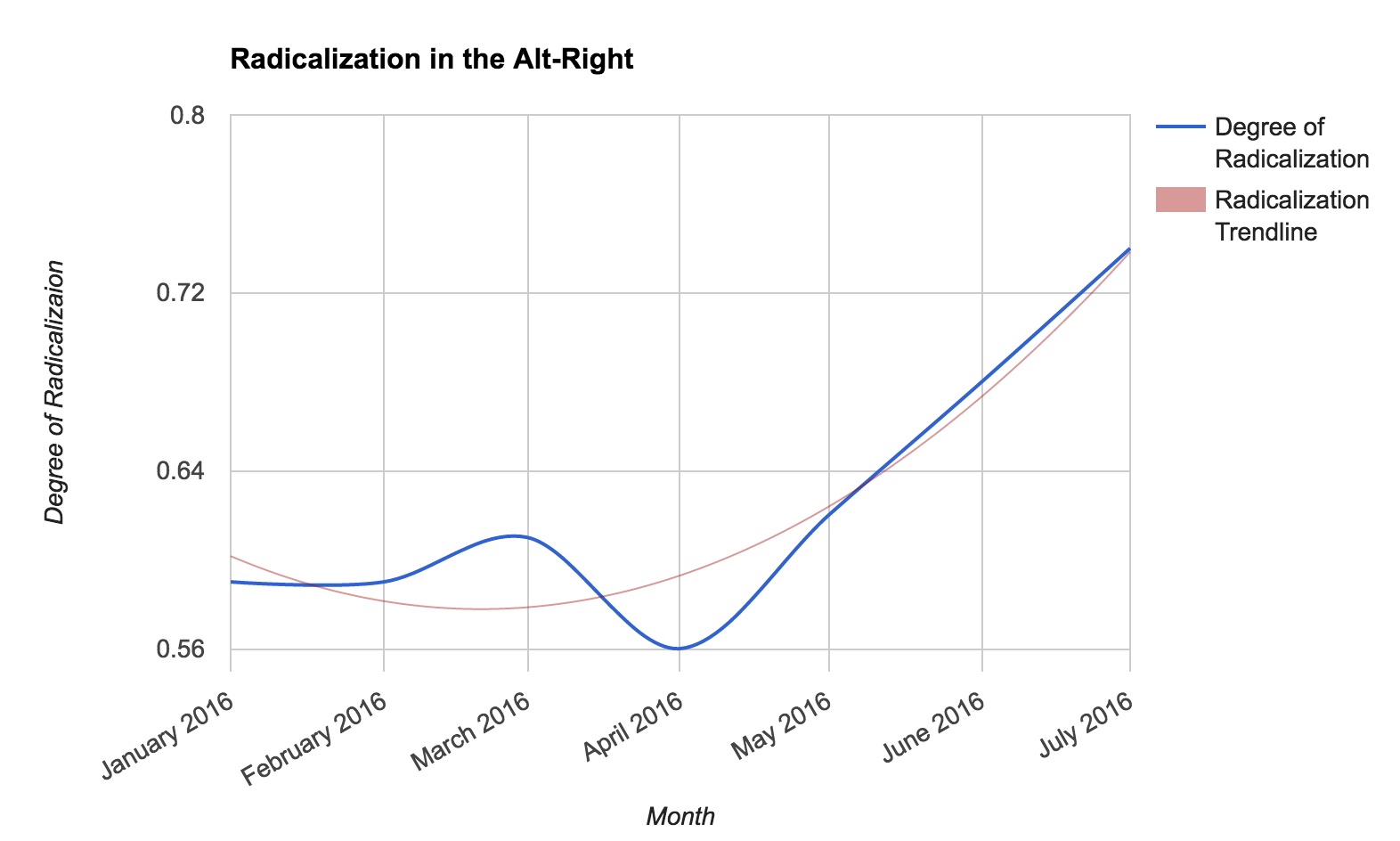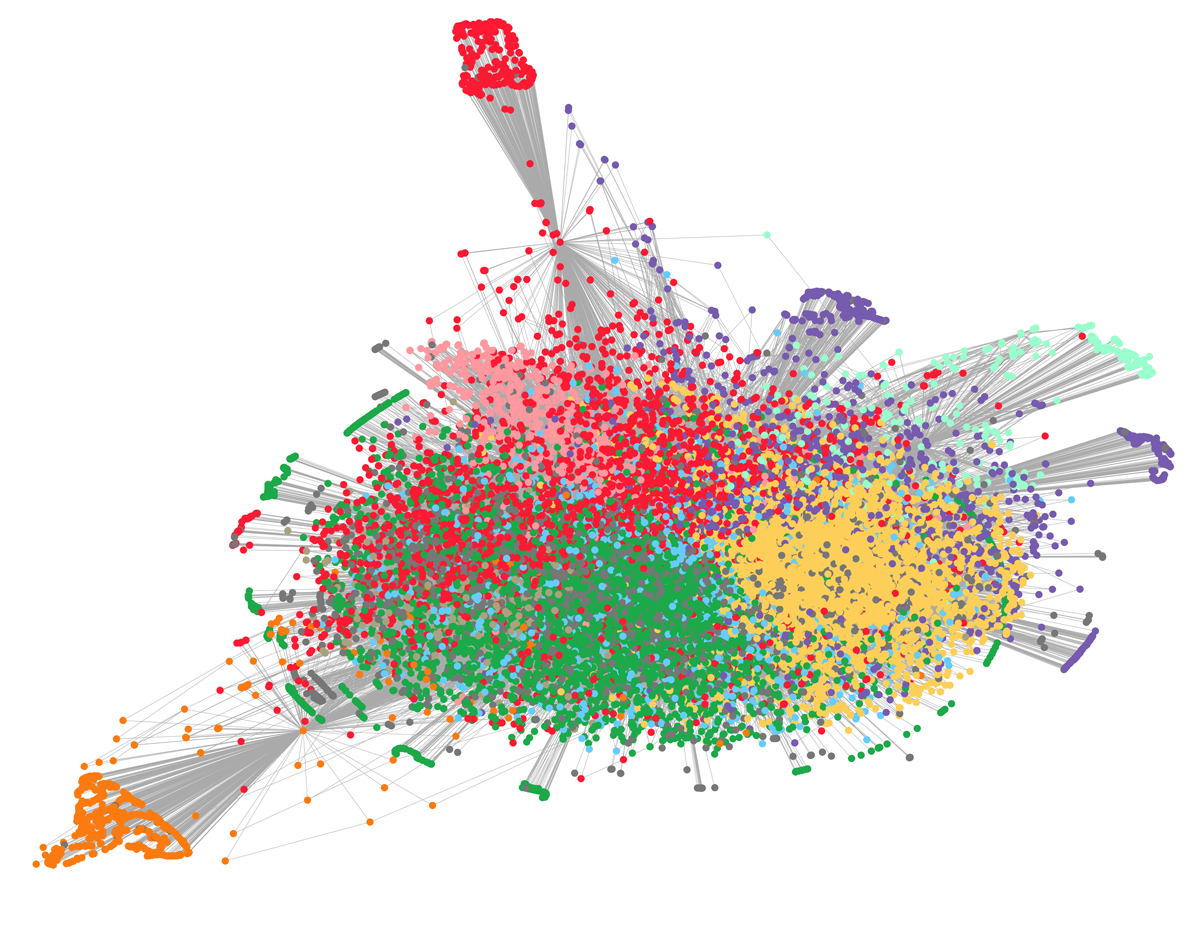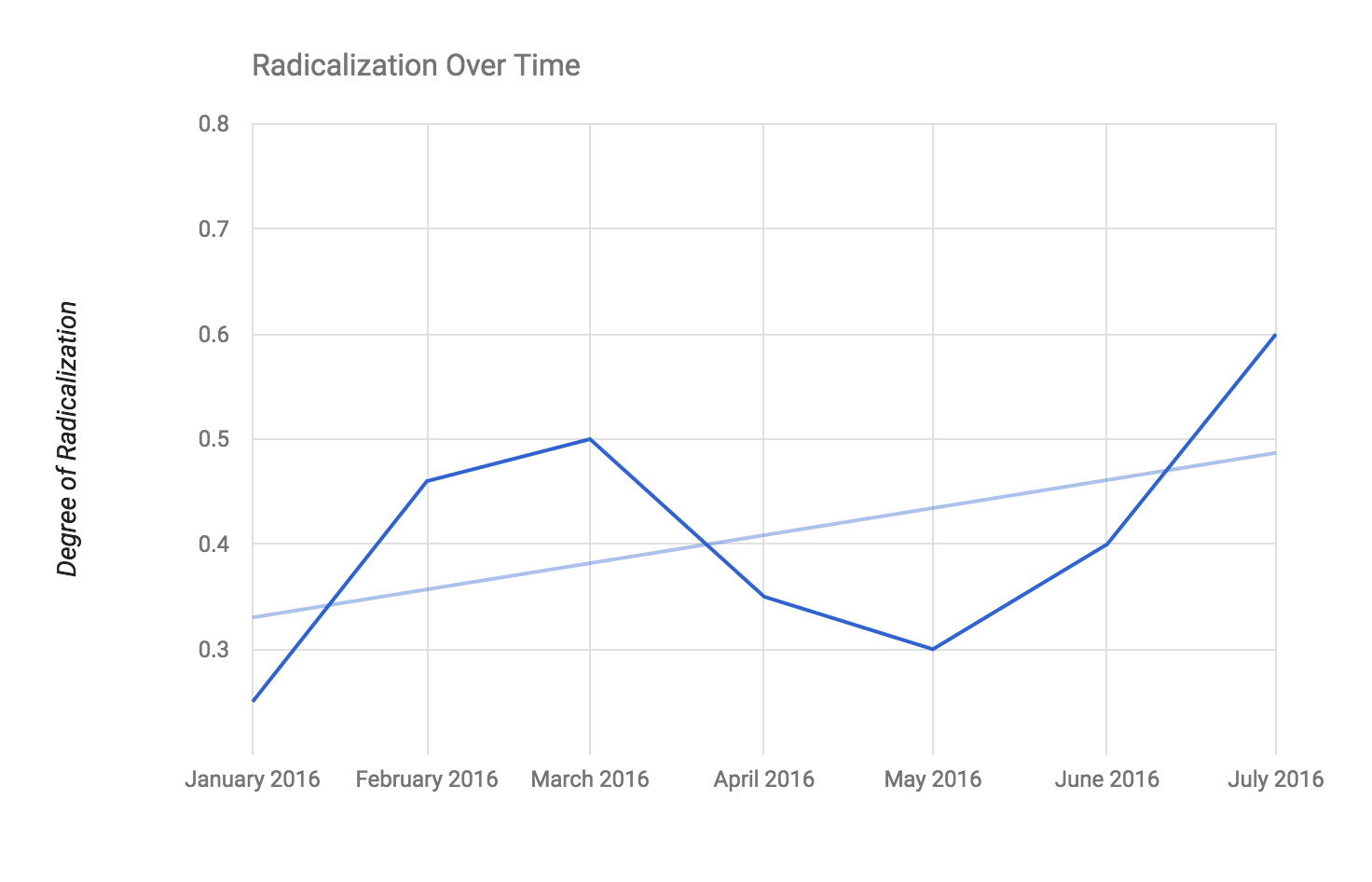The Radical Right and the Threat of Violence – Jonathon Morgan – Medium
 Twitter profile photos from extremist alt-right accounts
Twitter profile photos from extremist alt-right accounts
Earlier this week I shared a story on Twitter about anti-Semitism in Donald Trump’s campaign. The tweet was picked up by a prominent “alt-right” personality, and within a few minutes dozens of other white supremacists rallied to attack me, defend their candidate, and outline their vision for a society free of “Jewish control.”
While this little eruption might have been noteworthy nine months ago, swarms of unapologetic racists are now commonplace on social media. Formerly relegated to the fringes of society, the alt-right is now part of the political mainstream. This modern incarnation of the white nationalist movement, made up of neo-Nazis and white separatists, enjoyed the national spotlight recently as Hillary Clinton accused Donald Trump of openly campaigning for their support. Many in the media have rightly expressed concern that a major party candidate seems to pander (or at least “dog whistle”) to the far right fringe. Indeed, Trump has many ties to white supremacists on social media, and prominent white nationalists like former Klu Klux Klan leader David Duke are strongly supportive of the Trump campaign. But the truth is that, while the influence of this type of bigotry on our political process is alarming, the real threat posed by the alt-right goes far beyond any candidate’s unsavory political base.
The growing size and increasing radicalization of the white nationalist movement are indicators of a much more dangerous trend. With its vulnerable population, extremist ideology, and capacity for violence, the alt-right is a breeding ground for terrorism.
Terrorism, and the Path to Radicalization
Since the rise of ISIS, researchers, law enforcement, and the intelligence community have tried to understand how the group succeeds in inspiring people around the world to commit so-called “lone wolf” attacks, or travel to Syria to join their makeshift caliphate. This process, in which seemingly normal people become intoxicated with extremist ideology and are molded into terrorists, is often referred to as the “path to radicalization,” and it’s now well understood.
Many have followed this path, from different countries, and social classes, but they’re linked by common vulnerabilities — each feel ostracized from society, believe themselves to be victimized, and are attracted to violence. ISIS recruiters and propagandists exploit these vulnerabilities with narratives of strength and warmth, simultaneously empathizing with the alienated and disaffected while also promising power and belonging through righteous violence against their oppressors. ISIS sells potential recruits on the idea that they can fight injustice and find honor by taking back what is rightfully theirs.
An ISIS recruiting video. Warning: contains graphic footage.Though the similarities are not immediately obvious, for decades in the United States, white, working class communities have also become vulnerable to radical ideology. Described eloquently by author J.D. Vance in his lauded new book, Hillbilly Elegy, these communities in the South and rural Northeast are at the center of a growing social and cultural crisis. They’ve been rocked by a dramatic uptick in divorce, rampant drug overdoses, rising rural death rates, and a suicide epidemic. All this against a backdrop of increasing political irrelevance due to rural population decline and outright contempt from the wealthy.
According to researchers, these are also the communities with the highest levels of racism in the United States, and also overwhelmingly support Donald Trump for president.
This is not to say that all Donald Trump supporters are racist, or that all rural white voters are extremists — in fact that is almost certainly not the case. However it’s not hard to see why these communities feel ostracized, disempowered, and angry.
Fortunately current white nationalist leaders like David Duke and William Johnson are ineffective, and have largely failed to inspire the kind of unity and commitment that propels ISIS supporters to large-scale terrorist attacks, but communities infected by the alt-right are fertile ground in which extremism can, and has taken root.
And while racism is not the same thing as radical extremism, former radical Islamists have drawn direct ties between the ISIS brand of religious extremism and racism, and there are clear parallels between the radicalization process of jihadist extremists and the growing extremism of the far right in the United States. Put bluntly in this VICE documentary about the Klu Klux Klan in Mississippi, Steve Howard, the local KKK chapter’s Imperial Wizard, says:
“In some ways we can relate to Islamic extremists, just like we are Christian extremists, because they’re fighting a holy war and so are we.”
Growing Evidence on Social Media
Like ISIS, the alt-right is active on social media. In a recent research paper measuring alt-right on Twitter, J.M. Berger found a 600% increase in followers for prominent white nationalist accounts, even as ISIS activity has dramatically declined.
There are many factions within the alt-right, but in examining these white nationalists on social media, it’s clear there are two primary groups: garden variety racists, who complain about mixed-race couples, are proud of their Scots-Irish heritage, and use hashtags like “#WhiteWomenAreMagic,” and violent extremists, who call for genocide against Jews, the killing of Muslims and African-Americans, and even threaten to lynch President Obama.
These are not idle threats, nor is this a small fringe group, as many in the media on both the left and right would understandably like to believe.
Individuals ideologically aligned with extremist white nationalists are responsible for repeated incidents of online and offline violence — from the high-profile hacking of comedian Leslie Jones’ website, to the murder of a Lebanese man in Tulsa, OK, to the stabbing of a mix-raced couple in Olympia, WA to, most horrifically, the mass shooting at a Charleston, SC church by white supremacist Dylann Roof. In fact, until the nightclub shootings in Orlando, white extremists had committed more attacks and killed more Americans than jihadist extremists since 9/11.
Instead of chasing these extremists and their sympathizers back into the shadows, the recent increase in attention has only emboldened the alt-right. Jared Taylor, the editor of the white nationalist publication American Renaissance, openly cheered Hillary Clinton’s attacks on the group. David Duke mentioned Donald Trump as his inspiration for seeking a Senate seat in Louisiana, while Duke’s former organization, the KKK, is openly recruiting in Indiana, New York, and California. Meanwhile in Houston, an armed group of confederate-flag waiving white nationalists blockaded offices of the local NAACP chapter.
Measuring the Alt-Right’s Radicalization
Disturbingly, the social media activity of these hate groups suggests that the threat of violence is increasing. White nationalists’ online presence continues to grow, and after surveying a network of over 27,000 Nazi apologists, KKK members, and separatists, it’s clear that these groups are becoming measurably more radicalized every month.
Even though they typically hide their real identities behind the anonymity afforded by social media, alt-right Twitter users nevertheless clearly communicate their political affiliations. Using machine-learning algorithms to interpret the language in Twitter profile descriptions, and computer vision algorithms to identify pro-Nazi symbols in profile avatars, my colleagues at New Knowledge and I identified over 3,500 radical extremists amongst the larger network of 27,000 accounts that are associated with the alt-right.
Many hundreds of users display the swastika, while others choose alternative symbols associated with hate groups, such as the Celtic cross, Iron cross, and insignia of the Nazi paramilitary group, Schutzstaffel, also known as the SS.
 Swastikas dedicated by our computer vision algorithm, discovered in the alt-right network on Twitter
Swastikas dedicated by our computer vision algorithm, discovered in the alt-right network on Twitter
Many others explicitly declared their allegiance to neo-Nazi and white separatist movements in the text of their profiles by proclaiming “white pride,” or explicitly identifying themselves as “white nationalists.” Almost everyone in the alt-right network is an enthusiastic and vocal supporter of Donald Trump, through the core group of extremists is more likely to mention their race, white nationalism, and national socialism than any presidential candidate.
 On the left, words found most often in the larger network of alt-right Twitter profiles. On the right, words found most often in white extremist profiles.
On the left, words found most often in the larger network of alt-right Twitter profiles. On the right, words found most often in white extremist profiles.
Most importantly, analyzing the tweets of this core group of 3,500 extremists reveals a warped, dangerous worldview that openly advocates for murder and genocide.
Using recent advances in machine-assisted text analysis, we then quantified this racist, xenophobic, anti-Semitic, and violent perspective based on the context in which authors use relevant keywords. For example, in typical English, like a mainstream newspaper article, the word “Jewish” is statistically similar to words like “Muslim” and “Christian.” Meaning that mainstream authors usually rely on the word “Jewish” to describe someone or something religious.

On the contrary, in tweets by white extremists, the word “Jewish” is used in a totally different context, where it is statistically similar to words like “communist,” “homosexual,” “anti-white,” and “satanic.”

White extremists are therefore more likely to use the word “Jewish” to signify something they hate, rather than as a religious description. This is no surprise, but it provides an objective metric for understanding how the white extremist perspective diverges from the mainstream.
Imagine two poles at either end of a spectrum that spans from the moderate middle to the potentially violent, radicalized fringe — this metric places a community somewhere on that spectrum. It’s a kind of radicalization score, and those who score highly are ideologically similar to the most violent, dangerous alt-right extremists on Twitter.
When the radicalization score is applied to tweets from the broader alt-right network, it’s clear that the entire white nationalist community is embracing an increasingly extreme ideology. The social media content of white nationalists in July was 25% more radicalized than it was in January, and the rate of radicalization is increasing exponentially.
 The increasingly radicalized rhetoric of the alt-right on Twitter, measured.
The increasingly radicalized rhetoric of the alt-right on Twitter, measured.
Of course the alt-right is not a single group, but is comprised of many communities, joined by their shared belief in white supremacy. As this graphic shows, small factions are scattered across the larger white nationalist network.
 27,000 Alt-Right supporters on Twitter
27,000 Alt-Right supporters on Twitter
Some communities, like the “#BlueHand” movement, relentlessly and aggressively promote Islamaphobia, whereas other communities rail against diversity, which they describe as “#WhiteGenocide.” Still other communities align themselves with neo-Nazis and engage in Holocaust denial — largely focused on a recent pro-Hitler documentary called The Greatest Story Never Told — while some instead choose the white supremacist groups with roots in the United States like the Klu Klux Klan. There is plenty of overlap between these communities, and almost everyone in the alt-right revels in bizarre conspiracy theories, such as the idea that President Obama founded ISIS — a theory recently made popular by Donald Trump — or that Black Lives Matter activists are terrorists.
Regardless of what type of white nationalism the individual communities prefer, almost all of them show signs of adopting the kinds of dangerous, radical ideologies.

Looking more closely at one of these communities in particular, it’s possible to see the journey from casual racism to a more extremist typically associated with violence.
 An Alt-Right community on the path to radicalization
An Alt-Right community on the path to radicalization
This community of 5,225 users is tightly clustered inside the larger network, indicating a high degree of communication between its members. The tweets published by members of this community indicate a perspective that is 63% radicalized, and that has become increasingly radicalized over time.
 Community radicalization over time
Community radicalization over time
A closer look at the individual tweets published by members of this group in January, and then in July, illustrates this trend. In January, the word “Jewish” hardly appears. When it does, the context reveals an undercurrent of casual, but not aggressive, racism.
By July, the tone has changed. The word “Jewish” appears in tweets from hundreds of different accounts, and its usage implies a belief in large-scale conspiracy, racial antagonism, and even explicit support for Adolf Hitler.
Now, in September, the march toward radicalization shows no signs of stopping, as campaign rhetoric intensifies during the last leg of a polarizing presidential election.
Dark Times Ahead
The extremist alt-right is a barrel of gunpowder, waiting for someone to light a match.
It’s also not going anywhere. The radical alt-right has so far failed to engender the kind of devotion seen in supporters of other extremist groups, but Donald Trump and his campaign have normalized the hate and conspiracy theories that fuel this movement. His rhetoric has emboldened the alt-right, and this election cycle has dramatically elevated its visibility. The economic and social conditions that led to the decline of rural white communities aren’t changing anytime soon, and as the number of alt-right converts grows at an alarming rate, these groups seem increasingly inclined to violent rhetoric and radicalized ideology.
It’s only a matter of time before more charismatic and ruthless leaders replace uninspiring figures like David Duke and Jared Taylor, harness this increased capacity for violence, and elevate the radicalized alt-right from a marginalized hate group to full-blown terrorism.
A Trump supporter responding to his candidate’s speculation that the election might be “rigged.”